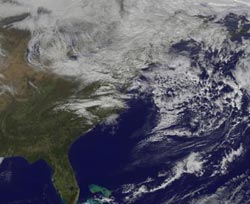Satellite still shows Sandy's remnant clouds over eastern Canada and the northeastern US

This visible image from NOAA's GOES-13 satellite shows the remnant clouds from Sandy still linger over the Great Lakes, east to New England and north into Canada at 1:31 p.m. EDT on Nov. 2, 2012.<br><br>Credit: NASA GOES Project<br>
The National Weather Service map for Nov. 2, 2012 showed two areas of low pressure over eastern Canada, near Quebec.
That's where the remnants of Sandy are located and the storm's massive cloud cover continues to linger over a large area. That low pressure area is associated with Sandy's remnants.
A visible image from NOAA's GOES-13 satellite at 1:31 p.m. EDT on Nov. 2, 2012 showed the remnant clouds from Sandy still linger over the Great Lakes east to New England.
In Canada, Sandy's clouds stretch from Newfoundland and Labrador west over Quebec, Ottawa and Toronto. The GOES image was created by NASA's GOES Project at the NASA Goddard Space Flight Center, Greenbelt, Md.
By Monday, Nov. 6, the National Weather Service map projects that the low pressure area associated with Sandy's remnants will be offshore.
Media Contact
More Information:
http://www.nasa.govAll latest news from the category: Earth Sciences
Earth Sciences (also referred to as Geosciences), which deals with basic issues surrounding our planet, plays a vital role in the area of energy and raw materials supply.
Earth Sciences comprises subjects such as geology, geography, geological informatics, paleontology, mineralogy, petrography, crystallography, geophysics, geodesy, glaciology, cartography, photogrammetry, meteorology and seismology, early-warning systems, earthquake research and polar research.
Newest articles

Properties of new materials for microchips
… can now be measured well. Reseachers of Delft University of Technology demonstrated measuring performance properties of ultrathin silicon membranes. Making ever smaller and more powerful chips requires new ultrathin…

Floating solar’s potential
… to support sustainable development by addressing climate, water, and energy goals holistically. A new study published this week in Nature Energy raises the potential for floating solar photovoltaics (FPV)…

Skyrmions move at record speeds
… a step towards the computing of the future. An international research team led by scientists from the CNRS1 has discovered that the magnetic nanobubbles2 known as skyrmions can be…




















